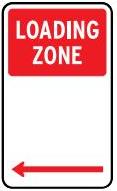In Australia, different states don't have the same laws about Loading Zones, so in this article, the regulations will be broken down, state-by-state.
In all states, a loading zone will be indicated by the following sign:

The arrow indicates where you can park, so in this case, you can only park to the left of that sign.
Also, if the loading zone indicates a specific time frame - for example, 10 minutes or Saturdays only - then that is the rule for that loading zone.
This article isn't legal advice in any way, shape or form, but it is meant to be a general indicator. Any penalties incurred from behaving unlawfully in a loading zone aren't the responsibility of GoPeople.
New South Wales
"Only drivers of vehicles "principally constructed for carrying goods" [assumption - this means utes, vans, trucks] may park their vehicle in a loading zone.
"These vehicles may stop for up to 30 minutes if they are being loaded or unloaded. A station wagon or a three-wheeled goods vehicle [ like a tuk-tuk] may control for up to 15 minutes.
"If you are driving any other vehicle, you may only stop to pick up or set down passengers at the kerb.
"Hours of operation may apply to some signs. This means restrictions apply for those times only."
Look out for the Loading Zone signs as well.
Links:
http://www.rms.nsw.gov.au/roads/safety-rules/road-rules/parking.html
Victoria
"You can stop in a loading zone for up to 30 minutes or as otherwise signed if you are dropping off, or picking up, goods or passengers and driving a:
- goods-carrying vehicle
- courier or signed delivery vehicle
- The truck which is dropping off or picking up goods
- Bus or vehicle which has seating positions for 10,11 or 12 adults (including the driver) that is being used to carry passengers for hire or reward
- public bus
- licensed commercial passenger vehicles such as taxis, hire cars or other special-purpose vehicles
"Other drivers must not stop in a loading zone, even if loading or unloading."
Links:
https://www.vicroads.vic.gov.au/safety-and-road-rules/road-rules/a-to-z-of-road-rules/parking#zones
Queensland
You can use a loading zone in Queensland if -
- "[You] are a truck dropping off, or picking up, passengers or goods - stopping 30 minutes at maximum.
- "[You] have a commercial vehicle identification label issued by the local government for that area (stopping 30 minutes at maximum).
- "[You} are dropping off or picking up goods (stopping no more than 20 minutes).
"The [loading zone] sign may show a different length of time."
In Queensland, Go People mainly operates in the Brisbane metro. The above rules mention a "commercial vehicle identification label issued by the local government for that area". So, if you don't feel like getting fined or want to become a better Runner, it would be advisable to obtain a commercial vehicle identification label from the Brisbane City Council and, if you'd like to, all other metros in the greater Brisbane area that Go People services (Moreton Bay, Ipswich, Logan and Redlands).
Links:
South Australia
South Australia has two main rules when it comes to loading zones.
"(a) A Commercial Vehicle that is dropping off, or picking up, goods are permitted to stop in a loading zone for a maximum of 30 minutes (unless another time is indicated)."
The definition of a 'Commercial Vehicle' given by Adelaide City Council is "a motor vehicle constructed solely or mainly for the carriage of goods". Examples of 'Commercial Vehicles' are trucks of any size, panel vans and utes, but not station wagons. These vehicles can spend up to 30 minutes in a loading zone.
The other rule they have is:
"(b) A Non-Commercial Vehicle is permitted to stop in a loading zone if the vehicle is dropping off, or picking up, goods that are difficult to handle because of their weight or size. Non-Commercial Vehicles may utilise the zone for as long as is indicated on the signs (usually 10 minutes) unless the signs state the zone is for commercial vehicles only."
Examples of 'Non-Commercial Vehicles' are sedans, station wagons, four-wheel drives, and people movers. These vehicles can spend up to 30 minutes in a loading zone.
The material also notes that even if you have registered a station wagon as a commercial vehicle for insurance purposes, it will still be regarded as a 'Non-Commercial Vehicle' when parking.
Links:
http://www.cityofadelaide.com.au/assets/Adelaide_City_Council_-_City_Parking__You.pdf (page 6)
Western Australia
The City of Perth says that "A person must not stop or park a vehicle in a loading zone unless— (a) the vehicle is a commercial vehicle or an authorised vehicle; and (b) a person is continuously...loading or unloading goods to or from that vehicle.
"A person must not stop or park a commercial or authorised vehicle in a loading zone for longer than the time indicated on the loading zone sign, or if no time is indicated on the sign for longer than 30 minutes unless authorised by an authorised person."
According to the City of Perth, a 'commercial vehicle' is a motor vehicle that is "(a) constructed, adapted or fitted for the conveyance of goods; and (b) used primarily for the [transporting] of goods, but does not include a vehicle constructed for the [transportation] of materials used in any trade, business, industry or any other work."
An 'authorised vehicle' is simply a vehicle that has been authorised to use loading zones. "The local government, the CEO [assumption - of the company where the unloading is taking place], an authorised person or by any written law to stop or park on (or on the part of) a thoroughfare or parking facility," can all make your vehicle authorised.
 Help Center
Help Center